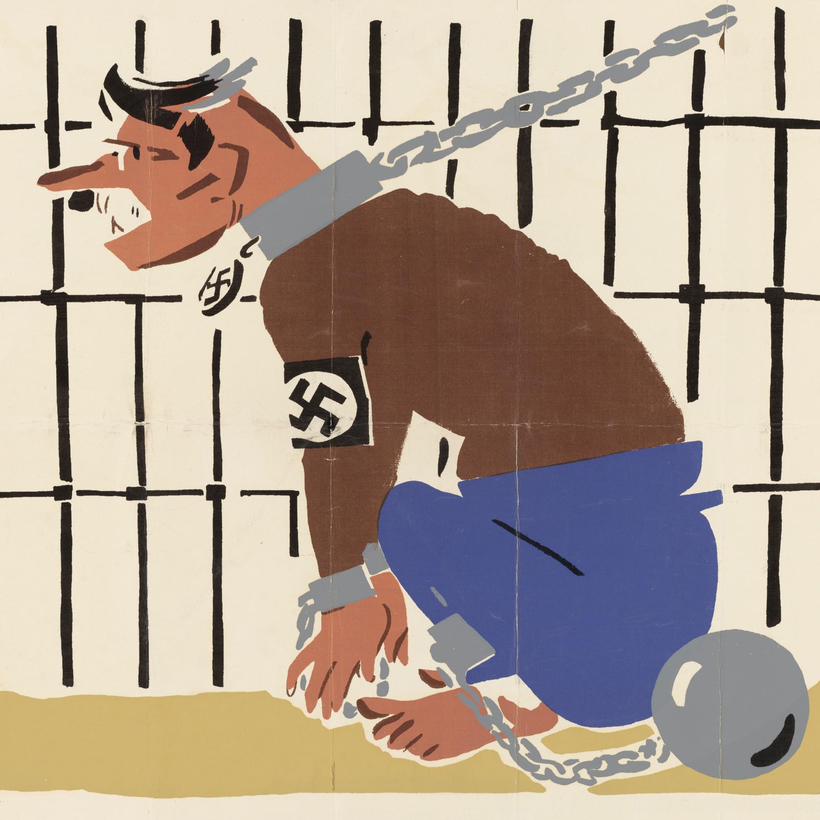Ask Americans about the presence of Nazi fighters in the United States during the Second World War and you’re likely to get a bewildered response. Some might know something about Operation Pastorius, the ill-fated June 1942 plot in which eight Germans covertly landed on beaches in Florida and Long Island intent on sabotage, only to be quickly apprehended by U.S. authorities. A few might remember that a German U-boat sank a 368-foot collier off of Port Judith, Rhode Island, on May 5, 1945, in the very last hours of active U.S.-German combat in World War II.
Most, though, will just think you’re crazy: everyone knows Uncle Sam fought the Nazis so effectively “over there,” they never had a chance to make it here.
But, in fact, during the war years, hundreds of thousands of German combatants did set foot on American soil—as prisoners of the United States. Between 1942 and 1946, more than 370,000 Germans were imprisoned in America, kept in over 600 camps spread across 47 states. At the height of the war, the transatlantic flow of captured Germans was so great that Winston Churchill, traveling to a May 1943 summit with Franklin D. Roosevelt aboard the R.M.S. Queen Mary, had to share passage with prisoners from Hitler’s fighting ranks.
In The Fifteen: Murder, Retribution, and the Forgotten Story of Nazi POWs in America, William Geroux recovers the fascinating history of what happened once German detainees reached the U.S. In a brisk and impressively researched narrative, he shows how, even during their American imprisonment, hardcore Nazis enforced fealty to Hitler with brutal and occasionally deadly force. The book revolves around a little-remembered U.S. effort to root out this violence, an endeavor which culminated in a secret, desperate round of hostage diplomacy in the final days of the Third Reich.
The idea of imprisoning German combatants in America was born of necessity. Under the terms of the 1929 Geneva Convention, prisoners of war were to be guaranteed decent food, housing, and heating—all of which were in short supply near the battle theaters of Europe and North Africa. When America entered the war, in December 1941, the country’s open expanses and full cupboards made it a logical destination to send boatloads of captured Nazis.

Compared to their compatriots held in Russian or, later, French prison camps, Germans in America enjoyed comparatively comfortable confinement. “Here we eat more in a single day than in a whole week at home,” one detainee observed in a letter back to Germany. A few resentful Americans even complained that the camps amounted to a “Fritz Ritz.”
Yet among the P.O.W.’s, who under Geneva protocols were permitted to retain their military command order, loyalty to Hitler was fiercely enforced. One detainee later claimed he “enjoyed more political freedom in the traditional German army than I would in an American camp.” Any German perceived by his fellow prisoners to harbor fondness for the Americans or doubts about Nazism risked rogue justice from hardcore Nazis, including gang beatings, forced suicide, and murder. The perpetrators made little attempt to hide their actions, sometimes even protesting American plans to bury murder victims alongside “honorable” Germans in the camps.
By late 1943, so many Germans had died under suspicious circumstances that the problem appeared epidemic. The killings were largely a function of lax American oversight: Geroux wryly notes that Secretary of War Henry Stimson “devoted more space in his diary to planning the Army-Navy football game than to the German POW camps.” But the perception of unchecked National Socialism on U.S. soil sparked an outcry: “I’ve got to talk to Franklin,” Eleanor Roosevelt said after learning about the crimes in the camps. “Right in our backyard, to have these Nazis moving in and controlling the whole thought process!”
In response, the army launched tribunals that ultimately delivered death sentences to 15 prisoners from various camps. Notified by Swiss intermediaries of the Americans’ plans, the Nazi regime responded by condemning an equal number of Americans held in its possession.

By then it was late 1944, with American troops on the march toward the German homeland and Hitler’s regime in terminal decline. American officials, frightened over the fate of their troops in the hands of desperate Nazis, launched into a remarkable secret back channel with the German government, hoping to arrange a prisoner swap. Geroux crafts a compelling account of this effort, no small feat given the spotty archival record to have survived the chaotic final days of the Third Reich.
At the end of the European war, in early May 1945, German P.O.W.’s in America were notified of their nation’s capitulation. A few of the most ardent stalwarts refused to believe the news, dismissing it as American propaganda. Soon, though, nearly all the German prisoners would return to Europe—some, home to Germany; some, to serve grueling sentences in the hands of other Allied powers.
What they ultimately found back home astounded them—a new world that could no longer be denied. Near the book’s end, Geroux quotes a returning P.O.W.’s recollection of the “tenseness” in his fellow prisoners as they approached their homeland in a boxcar. “I could see it in their eyes. They crowded to the doors for that first glimpse. Then they saw … and they’ll remember for all time. Ruin, desolation, and destruction were framed in that open door.”
Jonathan Darman is the author of Landslide: LBJ and Ronald Reagan at the Dawn of a New America and Becoming FDR: The Personal Crisis That Made a President


